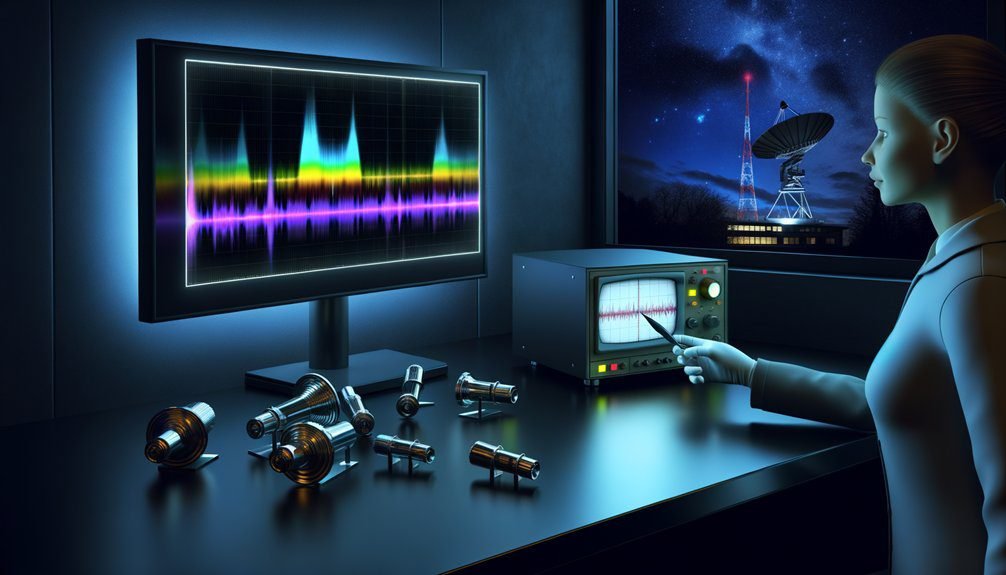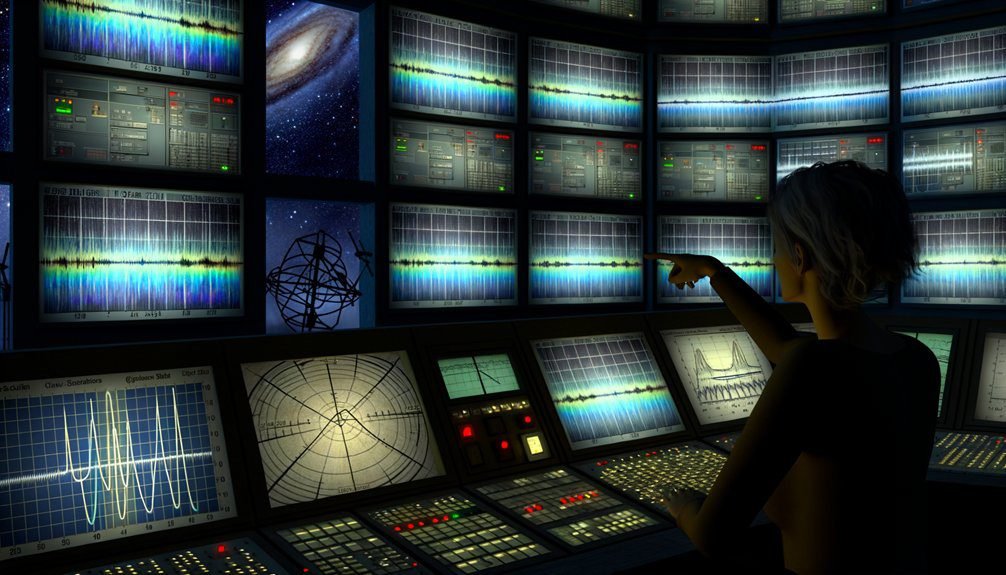You’ll fastest grasp SETI signal data by (1) characterizing signal and noise statistics—quantify spectral occupancy, SNR, kurtosis, Doppler drift and instrument provenance to separate carriers from thermal and RFI backgrounds; (2) applying layered signal processing—multitaper spectra, adaptive Wiener/Kalman filtering, chirp parameter estimation and spectral-coherence methods to extract discriminative features; and (3) correlating features with astrophysical catalogs, barycentric correction, and RFI/ionospheric logs to compute likelihood ratios, and continue for procedural follow-up guidance.
Key Takeaways
- Learn the basic signal types (narrowband carriers, broadband transients, and instrument artifacts) and how they differ in spectrum and time.
- Practice feature extraction (SNR, spectral kurtosis, chirp rate) to quantify detections and reduce false positives.
- Cross-reference detections with catalogs, ephemerides, and RFI/ionospheric logs to rule out terrestrial or astrophysical impostors.
- Apply layered signal processing (multitaper, adaptive filters, wavelets) to improve resolution and suppress noise.
- Use blinded injection tests and explicit statistical thresholds (FDR/likelihood ratios) to calibrate sensitivity and reproducibility.
Understanding Signal Characteristics and Noise Discrimination

Because raw SETI data combine narrowband carriers, broadband transients, and instrument artifacts, you need to parse observables by their statistical and spectral signatures to separate astrophysical signals from noise. You’ll categorize signal types by metrics: spectral occupancy, coherence time, Doppler drift rate, and polarization state. Quantify noise sources—thermal background, RFI, quantization artifacts, and ionospheric scintillation—so you can assign likelihood scores to candidate events. Use probability distributions (Gaussian, Poisson, heavy-tailed) matched to measured histograms to parameterize noise floors and detection thresholds. Implement feature extraction that reports SNR, kurtosis, spectral kurtosis, and time–frequency morphology; these reduce false positives when you cross-reference astronomical catalogs and ephemerides. Maintain provenance metadata—timestamp, antenna beam, backend configuration—to track systematic artifacts. You’ll iterate threshold selection with blinded injection tests to calibrate sensitivity and false-alarm rates. By treating characterization as hypothesis testing with explicit priors for signal types and modeled noise sources, you’ll optimize resource allocation for follow-up and maintain statistical rigor.
Applying Signal Processing and Pattern Recognition Techniques
When you move from characterization to action, apply a layered signal-processing pipeline that combines high-resolution spectral estimation, time–frequency decomposition, and statistical detection to isolate candidate events from pervasive noise and RFI. You’ll start with adaptive signal filtering techniques—Wiener, Kalman, and wavelet-thresholding—to suppress broadband noise and cyclostationary interferers while preserving narrowband transients. Next, deploy frequency analysis methods such as multitaper spectral estimation and high-resolution MUSIC/ESPRIT to resolve closely spaced carriers and Doppler shifts. Time–frequency representations (short-time Fourier, continuous wavelet, reassigned spectrograms) expose modulation structures; you’ll extract feature vectors (spectral peaks, chirp rates, entropy metrics) for classifier training. Use unsupervised clustering (DBSCAN, Gaussian mixtures) to reveal populations, then supervised models (random forests, convolutional nets) for candidate scoring, with cross-validation to prevent overfitting. Implement statistical detection thresholds with false-alarm control (FDR, Bonferroni) and metadata tagging for provenance, enabling reproducible vetting without conflating instrumental artifacts with astrophysical phenomena.
Correlating Observations With Astrophysical Context

As you shift from signal-level candidate selection to astrophysical inference, integrate multiwavelength and contextual datasets to discriminate terrestrial impostors from genuine extraterrestrial-origin hypotheses; this requires systematic cross-referencing of target coordinates, observation epochs, and spectral-temporal signatures against catalogs (Gaia, SIMBAD, VO-compliant surveys), transient alerts (TNS, GCN), and environmental telemetry (RFI logs, ionospheric indices). You should normalize time-stamped detections to barycentric reference frames, overlay spectral features onto archival spectra, and interrogate historical observations for repeatability or precursor activity. Use astrophysical models to predict plausible signatures—pulsar, maser, flare-star, or technosignature-like morphologies—and compute likelihood ratios comparing model-predicted observables with measured metrics (SNR, drift rate, polarization). Cross-correlation with transient databases will flag contemporaneous astrophysical events; correlation with RFI/ionospheric records will reduce false positives. Maintain provenance metadata for every association and quantify posterior probabilities for extraterrestrial-origin hypotheses, enabling reproducible triage and prioritization of follow-up campaigns.
Frequently Asked Questions
How Do Legal and Ethical Considerations Affect SETI Data Sharing?
Legal and ethical considerations shape how you balance data privacy with public access; you’ll need protocols ensuring ethical transparency while preventing misuse. You’ll adopt collaborative frameworks that define custody, consent-equivalents for monitored communities, classification tiers, and audit trails. Compliance regimes, liability allocation, and dual-use risk assessments constrain sharing velocities and formats. Consequently, your sharing policies become technical-legal artifacts designed to optimize scientific utility while minimizing privacy breaches and ethical harms.
Can Citizen Scientists Without Astronomy Degrees Contribute Meaningfully?
Yes — you can contribute meaningfully: public participation and citizen involvement augment detection pipelines, providing human pattern recognition, anomaly classification, and follow-up prioritization. You’ll need training in signal processing basics, statistical validation, and metadata curation; platforms provide tutorials and quality control workflows. Clear protocols, reproducible documentation, and coordinated channels for reporting enhance scientific utility. Your contributions lower false positives, increase discovery sensitivity, and democratize observational coverage across temporal and geographic baselines.
What Funding Sources Support Long-Term SETI Data Collection?
Imagine a 10-year monitoring project funded through mixed sources: government grants seed infrastructure, private donations sustain operations, nonprofit funding underwrites outreach, and research partnerships provide analysis. You’ll find government grants give stable baseline support, private donations add flexible rapid-response cash, nonprofit funding targets mission-aligned programs, and research partnerships leverage institutional expertise and shared facilities. You’ll need to diversify revenue streams, document outcomes, and build collaborative governance to guarantee long-term viability.
How Are False Positives Publicly Disclosed and Corrected?
Agencies and observatories disclose false positives through rapid signal verification protocols and public transparency channels: you’ll see initial alerts, follow-up non-detections, and technical postmortems. They publish metadata, calibration logs, RFI analyses, and retraction notices in centralized archives and peer-reviewed reports. You’re expected to scrutinize timestamps, instrument states, and verification thresholds; independent teams replicate analyses. Corrections update datasets, issue errata, and adjust detection algorithms to prevent recurrence.
What Training or Certifications Help Interpret SETI Datasets?
You should pursue formal training in data analysis, signal interpretation, and radio astronomy—degrees or certificates in astrophysics, electrical engineering, or data science help. Take coursework in time-series analysis, digital signal processing, Bayesian inference, RFI mitigation, and machine learning; obtain certifications in Python, MATLAB, or RF engineering where possible. Practical experience via observatory internships, citizen-science projects, and peer-reviewed publications sharpens interpretive rigor and methodological validation for SETI datasets.